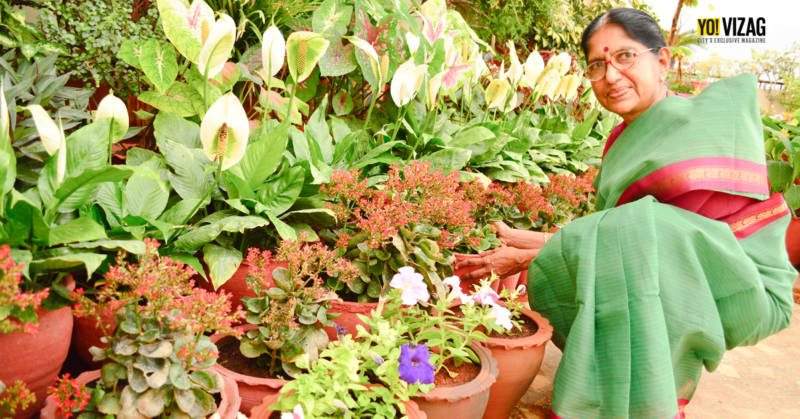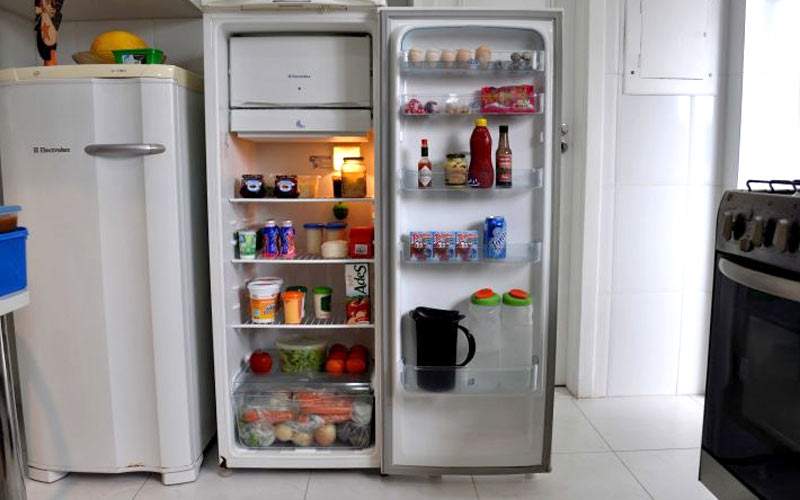A graduate from Andhra Medical college, a doctor practicing medicine for 20 years, a professional managing a nursing home, a gardener par excellence. No, we are not talking about a group of stellar people; we are talking about one single versatile powerhouse otherwise known as Dr. Uma Rani.
A genuine concern about the deteriorating environmental conditions set her off on a journey which helped her discover her green thumb. The very thought of the possible grim future that our nature-insensitive, self-destructive generation has in store, spurred her harder towards doing her two bits for the environment. Today, she not only has an envious oasis on her terrace, but being a strong proponent of kitchen gardening has a delightfully lush kitchen garden to boot.
She started her garden from scratch and now spends almost 2 hours daily catering to her plants. The garden currently is stocked with green leafy vegetables and it clearly reflects of the utmost care which Dr. Rani imparts. Even at her age, she still does all the tasks by herself, right from plucking withered leaves to digging. The most she accepts is help from her gardener who comes down once a week.
To amateur gardeners, her first edict is to treat plants like children. She is derides new gardeners who start off with a lot of flourish but fizzle out in the blink of an eye. To avoid this, she suggests starting off with small plants and adjusting one’s time wisely. Since she also struggled with the same dilemma of inadequate space as the rest of us, she promotes the idea of a potted garden for beginners. From personal experience, she recommends green leafy vegetable, tomatoes, chillies and other small plants as good candidates for potted gardens. It may seem like a monumental task, but she concludes by saying that once you have suitable pots and soil, gardening can be as easy as just tracking the watering schedule.
She started her own movement to fix the earth with little to go with but her passion and determination. Gardening was and continues to be a hands on task for her, with fringe benefits that far outweigh the investments required. But more than the greenery, more than the fresh produce and even more than the beauty that a garden brings, it is the palliative tranquil that it induces which is a treasure. So get on your knees, dig deep and watch nature work up its magic.
DIY
With the soaring prices of food and the incessant news on the chemical overload in produce, most of us, at one or the other time have mused over the possibility of growing our own food. So, what stops a kitchen garden from being a ubiquitous part of our city lives? Is it lack of enthusiasm and energy? Well, we have for your reading pleasure, a gardener who at twice our age, has quadruple our energy. Is it lack of time? By our calculations of what we recommend, you will use up all of ten minutes of your time daily. Is it lack of knowledge? Then this article will provide you all that you need to get started with the basics. It doesn’t need a green thumb, it doesn’t need a big large space and it definitely isn’t rocket science. So why not give it a shot?
Getting Started
A few pots (sized more than 6 inches, preferably 12 inches in diameter)
You can choose either the plastic pots available in practically all super markets or clay pots usually found in nurseries. Avoid cement ones if you plan to do most of the work without help, because these are quite heavy.
Soil
This can again be easily procured at any nursery.
Seeds/seedlings for what calls out to you the most
Don’t go planting that crow on your window sill. You can get seeds in any agricultural shop.
Now that you have the ingredients listed, let us move on to the process.
Preparing the pot
You first need to create a small hole at the bottom of the pot to ensure extra water drains out. Then, cover the hole with large pieces of stone/chipped bricks etc so that the soil doesn’t flow out along with the water. Next, place a small plate/ saucer under the pot so that even if the soil drains it doesn’t mess up your floor. Finally, fill in the soil till it uses up 3/4th of the pot. And voila! You have a container ready to go.
Planting the seed or seedling
This month we will only cover plants low maintenance plants which only need watering from time to time. These plants are self sufficient and not prone to the bad company of pests. Short of plucking their own selves and conjuring a meal for you, these little green wonders know everything else.
Fenugreek
This one needs no trip any shop at all. What you might need is a trip to your local grocery store. Pick up the dry methi seeds used as seasoning. Soak it in water over night and let it sprout. Then scatter the sprouts close to each other (maximum 2 to 4 inches apart) in the pot. Now cover it up with a ¼ inch of mud and you are good. If you like using the tiny leaves (for their bitter taste), you can harvest fenugreek within a week. If you are looking for the slightly bigger leaves, you need to wait a month before your efforts pay back. To keep a constant supply of fenugreek, re-plant the sprouts every three weeks.
Uses: Were you aware that fenugreek is touted to give spinach a run for its iron.
Fennel
These little buddies have territorial issues. They need their space. Ideally, plant four seeds, in a 12 inch pot, well spaced apart. Cover the seeds with ½ inch deep soil and then wait for a week or two for the seedling to appear. Keep the healthier of the two seedlings. Discard the other two. Once the plant grows 6 inches tall (about 40 days later), you can start pruning the leaves in the top 2 inches of the plant, for use. Harvest the seeds when they turn from green to brown.
Uses: You might want to try using the leaves for garnishing your salads and soups. The stalk can be substituted for celery in all dishes. You can also tempt yourself to some fennel tea made by boiling the leaves for about ten minutes.
Chillies
Chillies are sun loving sturdy plants which thrive better when it is hot. You can even use the seeds from the dry red chillies we use in our kitchen but you may better off buying it from a store. Once you have your seeds, plop them into water for 2 to 4 hours. Once the seeds sink to the bottom, put a few seeds (3 – 4) in a pot and cover them up with about ¼ inch of mud. The seedlings will usually appear in about 14 – 20 days. Keep the largest one of the seedlings that emerges. Chillies grow into bushes so you should have only one or at most two plants per 12 inch pot. First, will come the flowers and once the flowers fall off, you will see the fruits of your labour. You can pluck the chillies either when they are green or you can wait for the chillies to turn red. The later you pluck them the hotter they are.
Uses: Did you know that chillies are known to be excellent for weight loss? If you are looking to lose some of that flab, you may have just found your new best friend.
Curry leaves/Kadi Patta
This fragrant herb is a delight to have in the kitchen garden both from an aromatic perspective and because of its sturdy constitution. You need to get a healthy seedling from your local nursery. The thicker the stem the better it is. For the first few days after you transplant the seedling into your regular pot, keep it in the same condition as it was in the nursery (indoors/in shade/in semi shades are etc.).Make sure the plant gets ample sunlight. Once the plant grows more than 2 feet tall, use leaves as and when required.
Uses: Boil it in coconut oil till it reduces to a black residue and then apply the oil to your hair for some very healthy spa conditioning.
Mint
This one is practically a weed when you consider its growth rate. Next time when you buy some mint from the store keep a few sprigs away for the garden. Take one sprig, cut it off right above a leaf junction. Make a small hole in the soil and place this stalk as deep as you can without burying the leaves. You can plant 4 sprigs in a pot about 4 inches apart. You will know within 3 – 4 days if the plant has taken root. Within a few weeks the plant will grow up and you will see fresh big leaves. When you are ready to use, first pluck the bigger leaves, this will allow the smaller leaves some space to grow. Once a year, either split it into multiple pots or move it to a larger pot; else it will flounder because of lack of space.
Uses: Refrigerate a few leaves in a jar of water along with lemon slices and cucumber overnight for a healthy invigorating drink. You can also leave a few leaves around the house. It is an excellent insect repellent and room freshener.
Coriander
Coriander is the most delicate of the lot. It really can’t take the sun, so you need to put this one in the shade. You can either plant the seed whole or try this neat little trick. Gently rub the seeds to split them. Then plant these split seeds, they grow faster. Irrespective whether you plant whole or halves, the seeds can either be scattered or placed in rows spaced about 4inches apart. Cover the seeds with ¼ inch of mud. You can start harvesting the moment the plant grows about 5 inches tall. Never cut off more than half the stem length at any time. If the flower buds appear, pinch them off. This might provide you another harvest of leaves. If not, then pluck the flower buds, dry them for use and remove the entire plant. Plan to replant the seeds every three weeks to ensure a continuous supply.
Uses: Use the well washed roots of the plant as a replacement of coriander in the Thai sauces. They have a more potent taste.
Spinach
Yes, you can be Popeye too! This forgiving, gardener friendly plant will keep your iron pumping. Plant the seeds 3 inches apart, in rows that are also 3 inches apart. This plant can even grow in small trays as shallow as 6 inches. Plant the seeds ½ inch deep. You should see seedlings in about a week. You will see a healthy harvest by the end of month. When you have at least six healthy leaves per plant you can start cutting the bigger leaves for use. This will let the smaller ones grow faster. You can expect to reap four to five harvests per plant. After that pluck it out. If you plant seeds recurrently every ten days you will have a continued supply of spinach throughout the year.
Uses: A glamorous quick fix; Sauté tender spinach leaves in olive oil with garlic, sesame seeds, salt and pepper.
Okra/ Ladies Finger
A proper vegetable fresh off your garden! Doesn’t that throw you into a tizzy? This one is best planted in multiple pots at the same time. Depending on your consumption go for 5 – 10 pots. Plant two or three seeds in a pot by pushing them an inch deep into the soil and then covering up with mud. They will take about a week to germinate. Once they grow at least two leaves each, keep the healthiest and the tallest of the lot, per pot. In about 6 weeks your plants will start flowering and from these flowers the pods will emerge. Harvest when the pods are 2 – 4 inches long. They will be primed for consumption at this size. Don’t wait for the pods to grow bigger as they become tougher to eat and cook.
Uses: Did you know you could use the leaves in salads?
Lemon grass
You can make it simple or you can make this difficult. If you want to go the hardcore way, plant about 5 to 10 seeds, 1 inch apart and keep the soil moist till you see little shoots emerging. Once the seedlings are about 4 inches tall, discard the weakest half and retain the strong ones for growth. If you want a simpler approach, obtain some lemongrass stalks with a thick green base and a little root showing. Thicker and greener the stalk, the better it is. Put these stalks into a jar filled with an inch or two of water. Change the water in the jar every day. Once the stalks grow some roots (within three weeks), transplant the stalks into a pot. Place the stalks about three inches apart and cover the roots up with soil.
Irrespective of how you start off, you should ensure the pot is a well drained one. Treat lemongrass to some nice sun and it will be happy as a clam. You can harvest this plant when the stalks grow about ½ inch thick by cutting the stalk a little above soil level. Keep harvesting frequently to ensure a healthy plant.
Uses: Peel lychees and place the excess syrup in a pan. Add sugar and lemongrass to this syrup and heat for about three minutes. Let it cool and then pour this lemongrass infused syrup over the lychees for a very zesty fruit serving.
Cheat sheet
A simple thumb rule is to plant twice the number of seeds than you need. Once the seedlings appear, discard the weaker, drooping halves and keep the healthiest lot. This will increase the chances of your success.
Change the soil in your pots yearly, it will keep the soil nutritious and your plants healthy
With most plants, watering never means soaking. Plants need a good drink periodically, as with all living beings, they don’t take nicely to being drowned.
Most plants thrive in places where they see some morning and evening sun and are not exposed too long to the harsh afternoon sun.










Discussion about this post